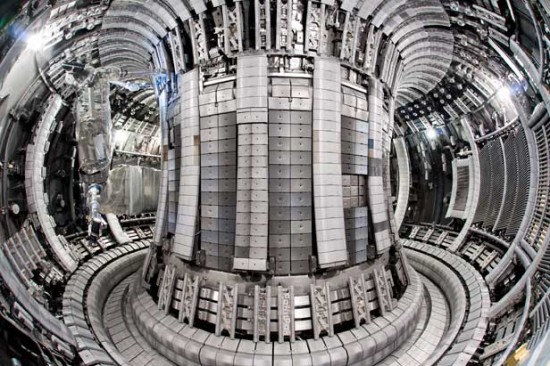Sustainable Energy
Europeans Reignite Fusion Energy Project
The test of a new lining that can take the heat of fusion could be crucial for a planned reactor in France.



A team of researchers has restarted the world’s largest fusion experiment—the Joint European Torus (JET) reactor, near Oxford, U.K. The move is a step forward in the quest for practical nuclear fusion.
The project was put on hold while a new lining was installed. This lining mimics the planned configuration of the International Thermonuclear Experimental Reactor (ITER), a full-scale experimental fusion reactor now under construction in southern France. As a consequence, the new undertaking at JET is being called the ITER-Like Wall Project.
The JET team says the lining, made of tiles of the light metal beryllium, should be better able to withstand the extreme conditions needed for a self-sustaining fusion reaction than the carbon-fiber composite tiles used before. The lining will also allow for laser-driven fusion experiments, similar to those underway at the National Ignition Facility in California.
JET is a tokamak—a device for carrying out magnetic confinement fusion. Its doughnut-shaped reactor contains plasma made from hydrogen that’s squeezed by powerful magnetic fields. Eventually, magnetic pressure and heat force the hydrogen nuclei to fuse into helium, releasing a burst of energy and freeing high-energy neutrons.
JET is the only tokamak in the world equipped to use tritium, the radioactive form of hydrogen containing two neutrons in its nucleus, as well as the single-neutron form, deuterium. Forcing these two forms of hydrogen to fuse produces large yields of energy. The ITER tokamak will also use this form of fusion once it’s complete.
Guy Matthews, director of the ITER-Like Wall Project, explains that ITER would not be able to operate with a carbon lining. “Electrons in the material tend to dilute the plasma—each one will displace a hydrogen nucleus,” he says. “This is why carbon was chosen; it has a low atomic number, and carbon fiber can withstand high temperatures.”
The problem comes with introducing tritium to the plasma. “If you have it in the wall, it will tend to form hydrocarbon compounds with the hydrogen in the reactor, and when the form of hydrogen is tritium, the hydrocarbons will be radioactive,” says Matthews. “That’s a radiological issue, a safety issue, and an economic issue, because there isn’t much tritium available, and you don’t want it trapped.”
For JET, this isn’t an overwhelming problem; the doughnut-shaped “torus” is relatively small—about two meters across—and only runs fusion pulses for a few tens of seconds. But ITER’s torus will be almost 10 times that size and run 10-minute pulses; and a commercial fusion reactor would have to run continuously.
The beryllium tiles used to refit JET are machined into precise shapes with a deep grid of cuts designed to prevent stresses developing as the tiles heat and cool during the reactor’s operation.
The reactor is lined with 5,000 of these tiles, which cover every part of the interior apart from a trench running around the base of the torus. Known as the diverter, this is where plasma particles are slowed down to expend their energy. At this stage the plasma is in direct contact with the lining, which is made of tungsten tiles, as the heavier metal is less likely to be displaced from the surface by light helium and hydrogen nuclei, Matthews says.
The refit of JET took around 15 months. All of the tiles from the former lining had to be stripped out and replaced with beryllium or tungsten. Because the reactor shell itself has been rendered radioactive by neutron bombardment, the bulk of the work had to be carried out by remote operation.
The work is also likely to have implications for laser-driven fusion research, according to Chris Matthews, director of the High Power Laser Energy Research (HiPER) project, a European attempt to devise a power station-like fusion reactor running on the same principle as the National Ignition Facility.
“The first wall is an area where we and magnetic fusion have a crossover of interest,” he says. “The environment is rather different, because ITER has a constant plasma loading, whereas we have to deal with a pulsed load, but we’re hoping to benefit from the research that’s going into the ITER-like wall.”